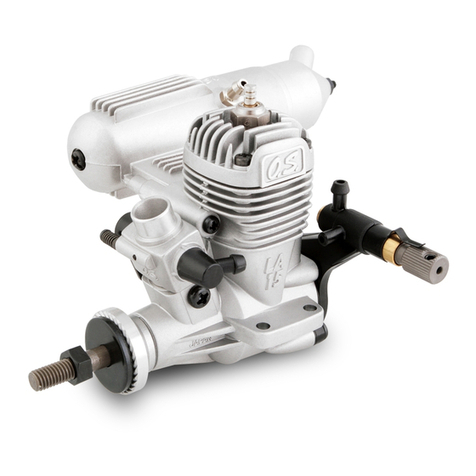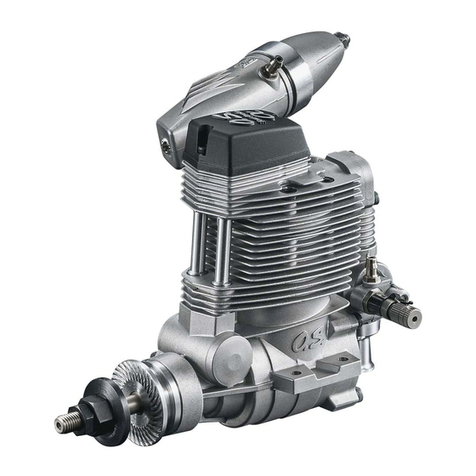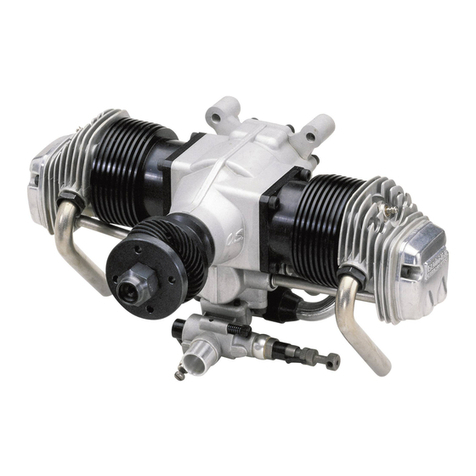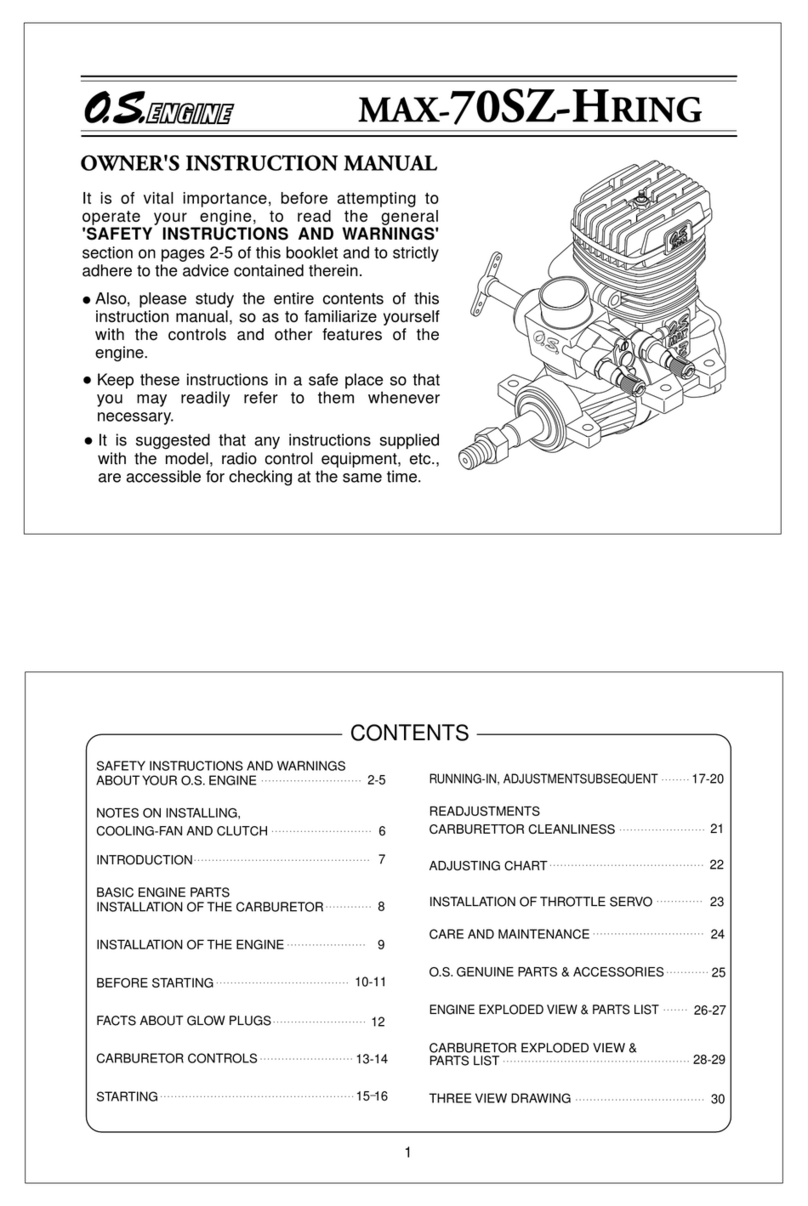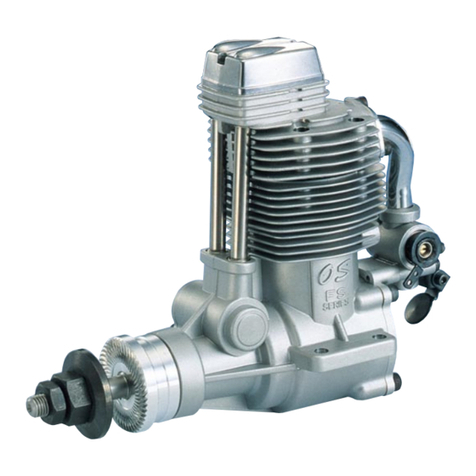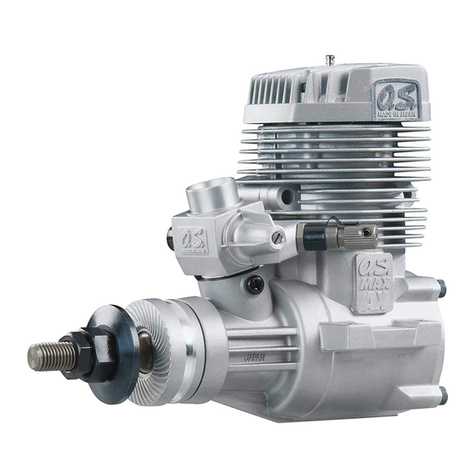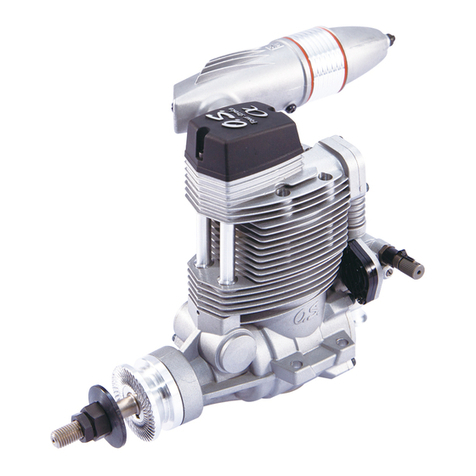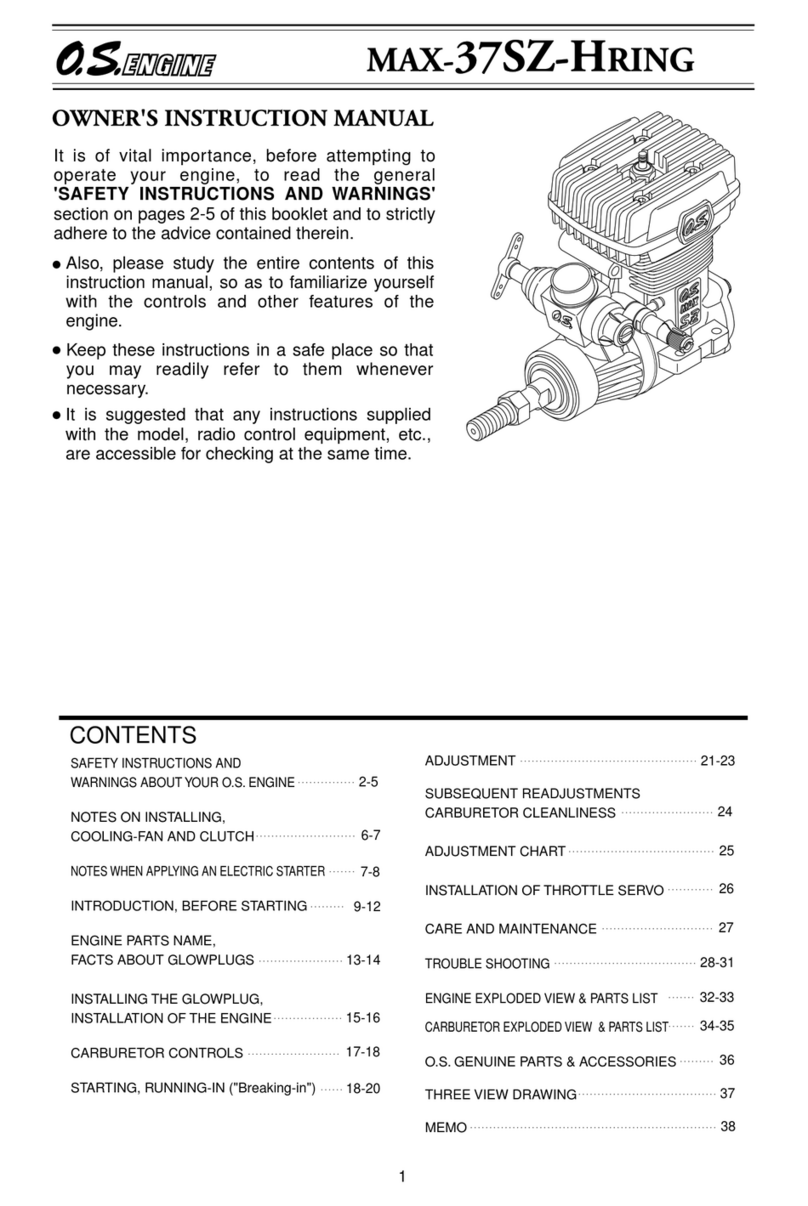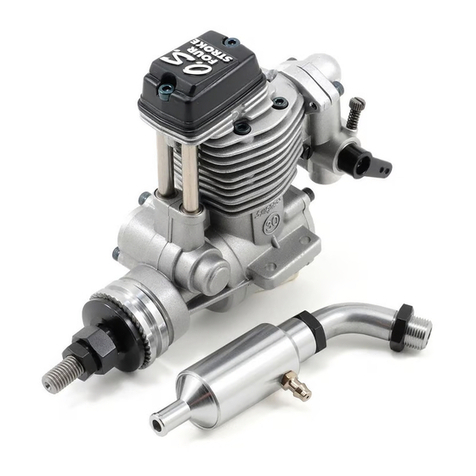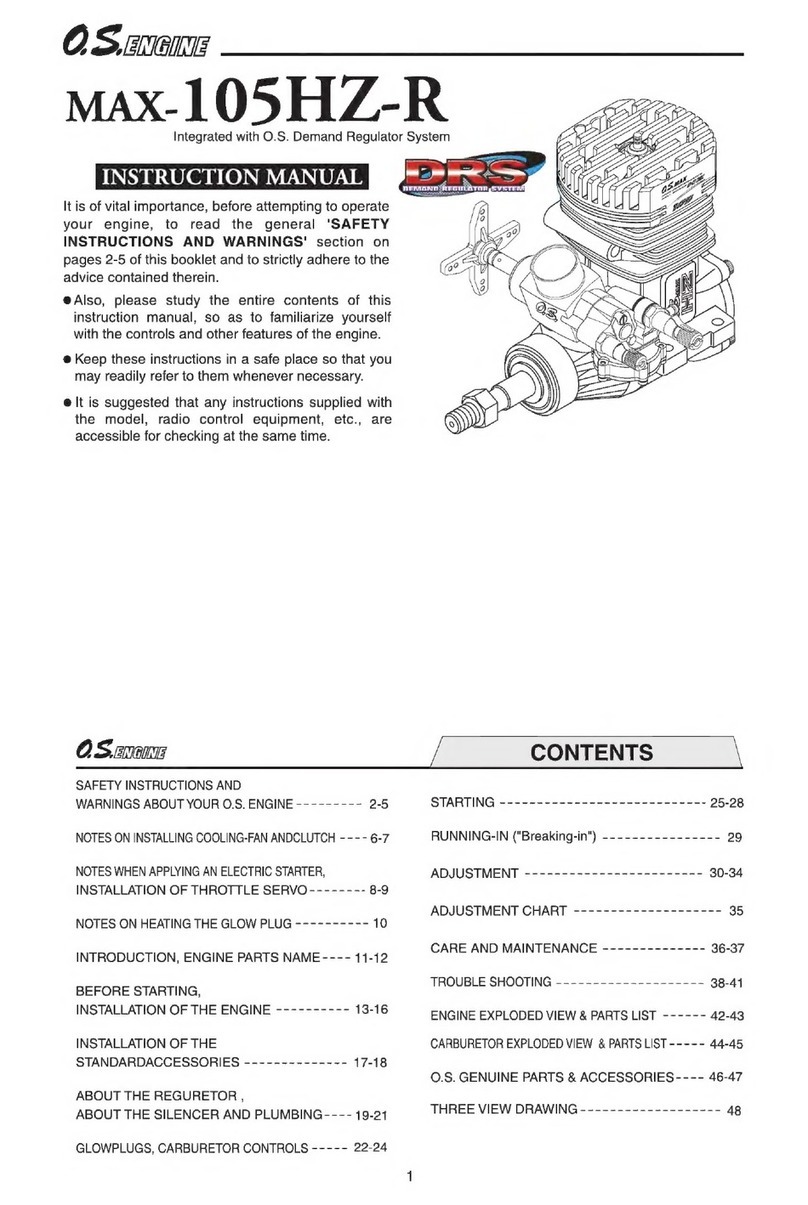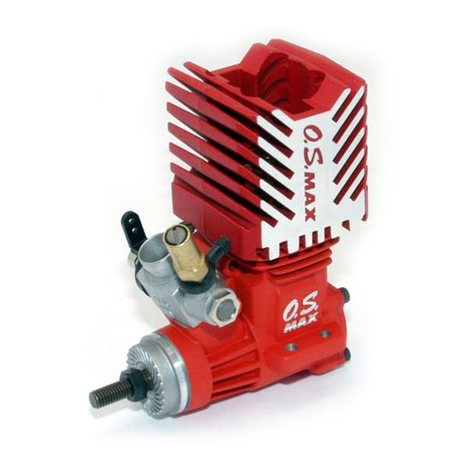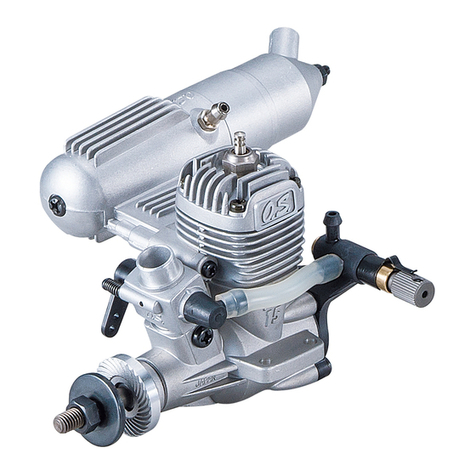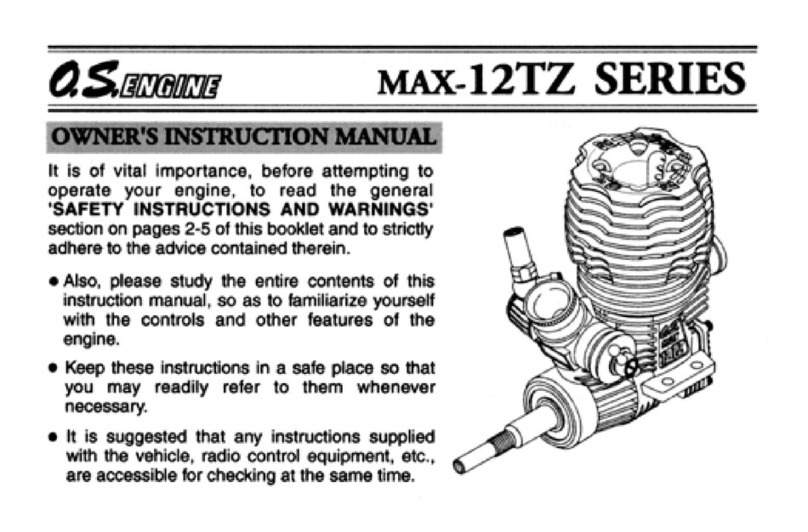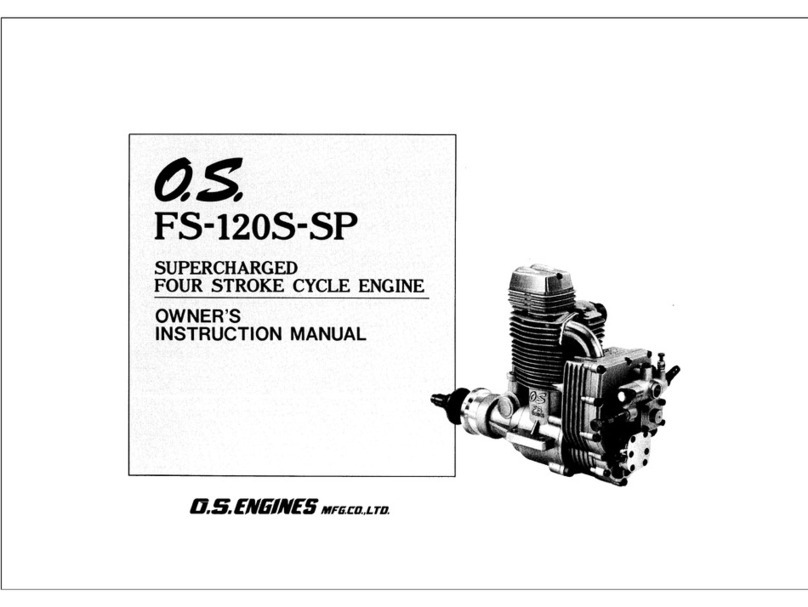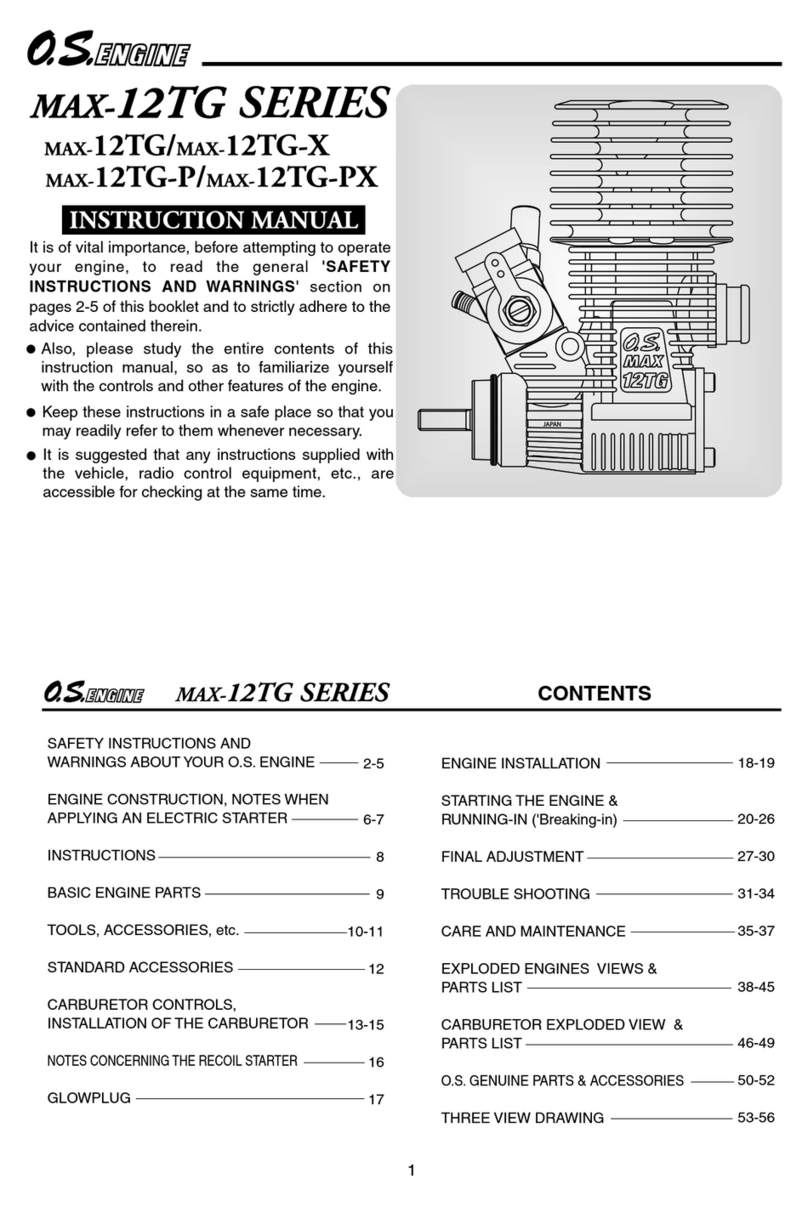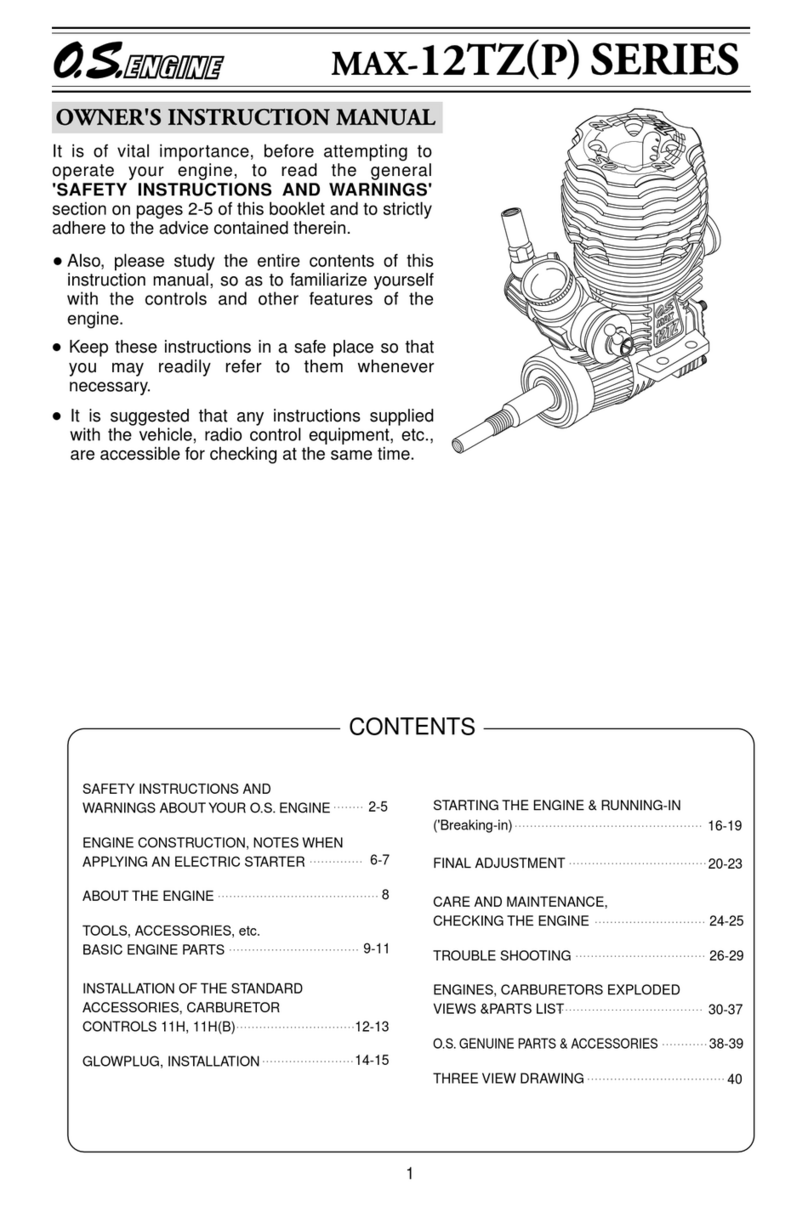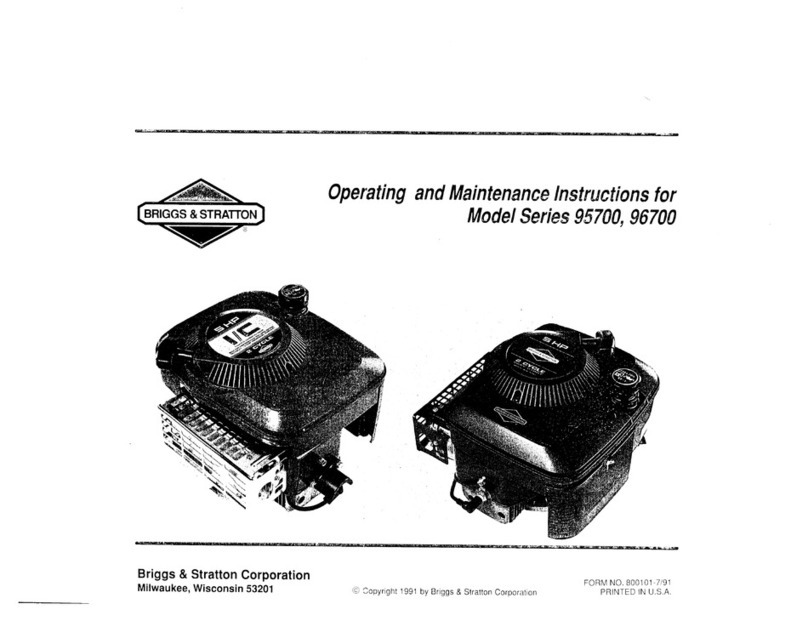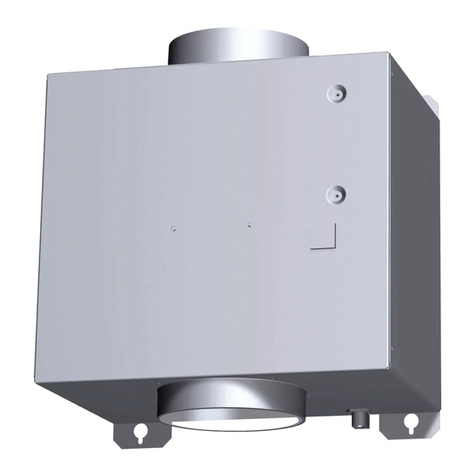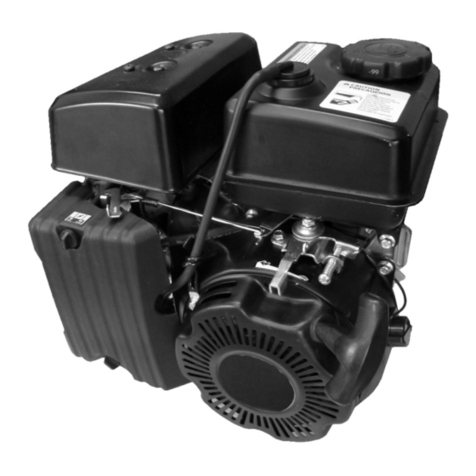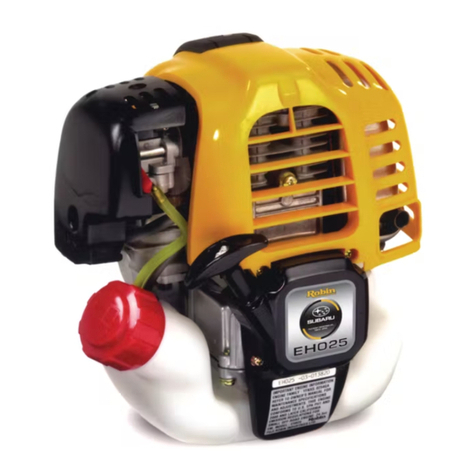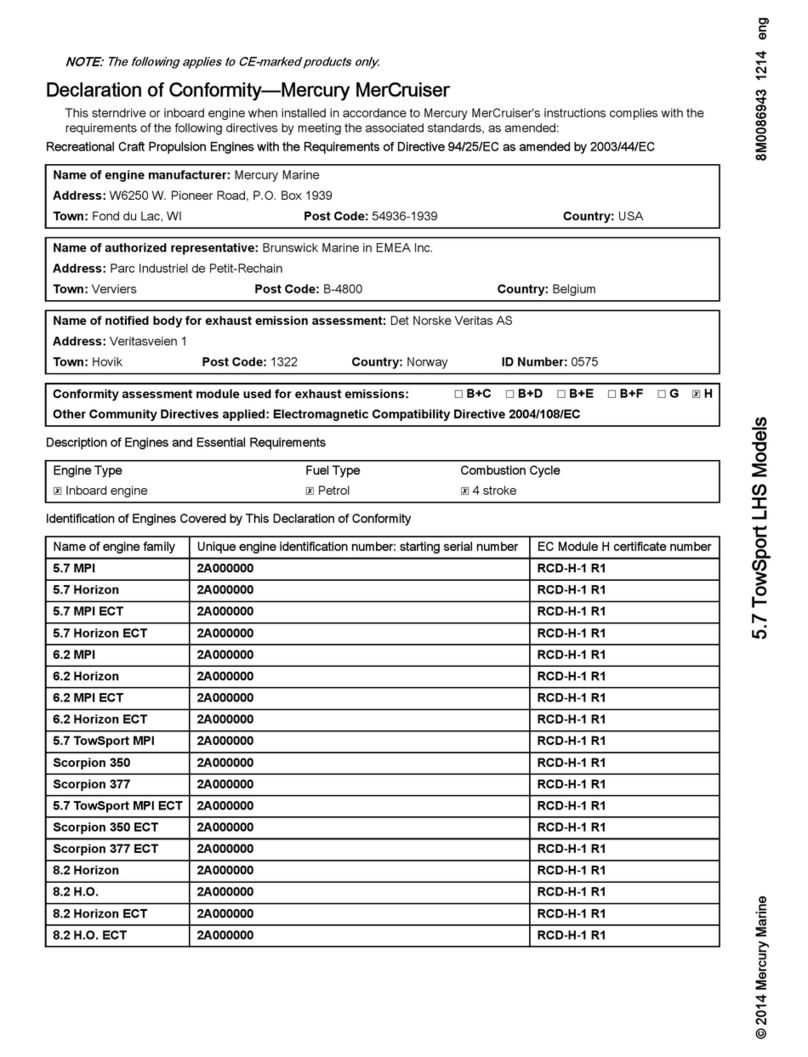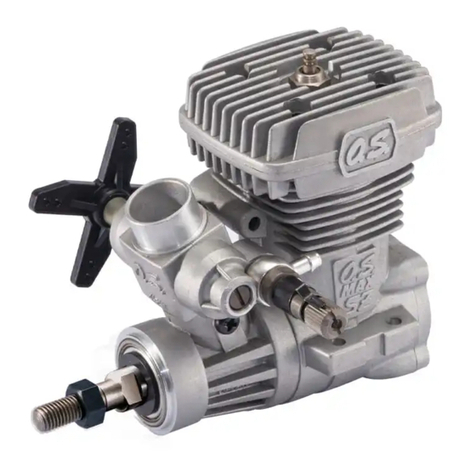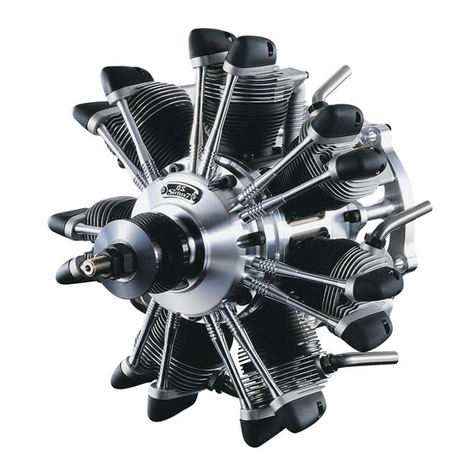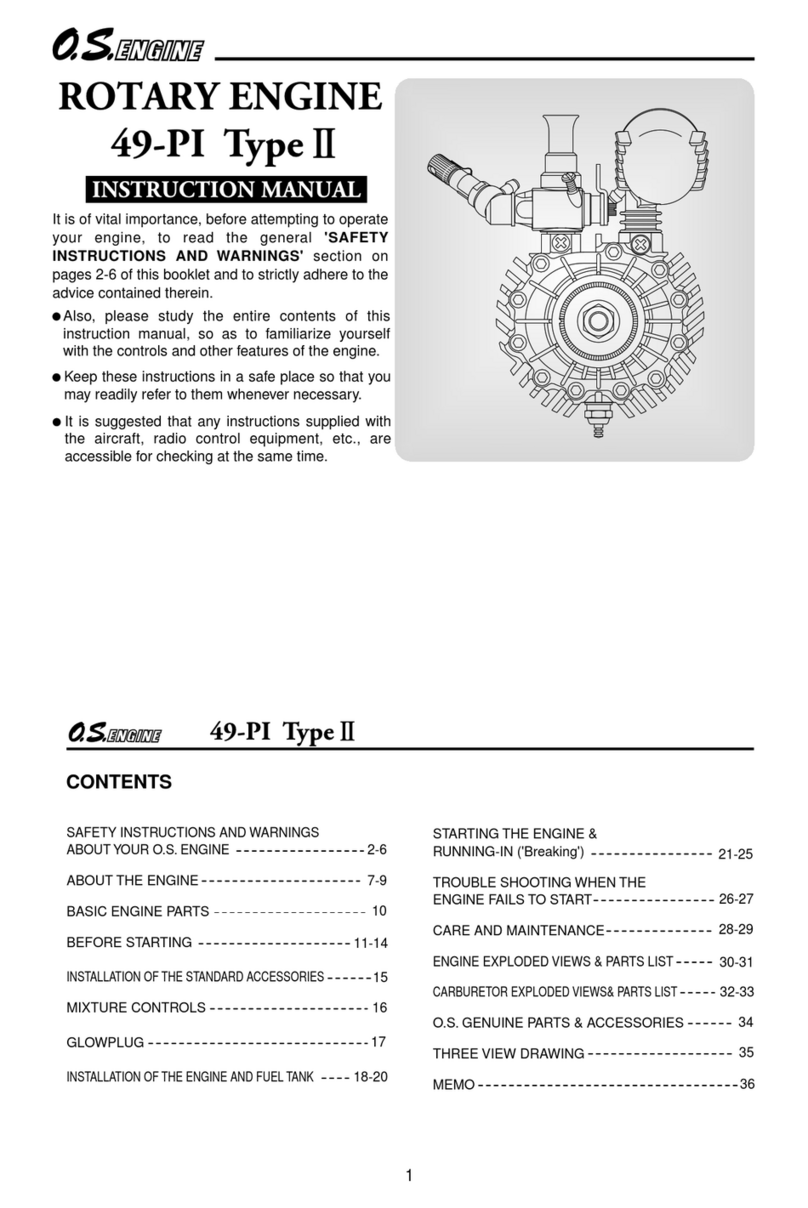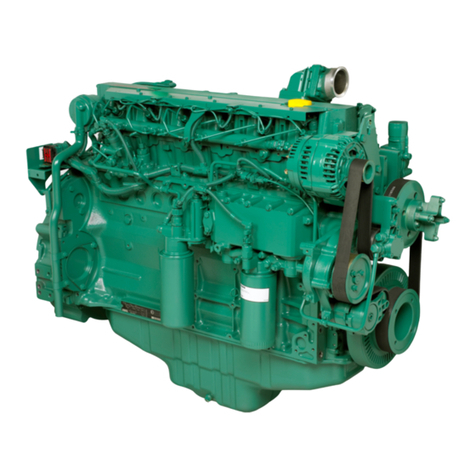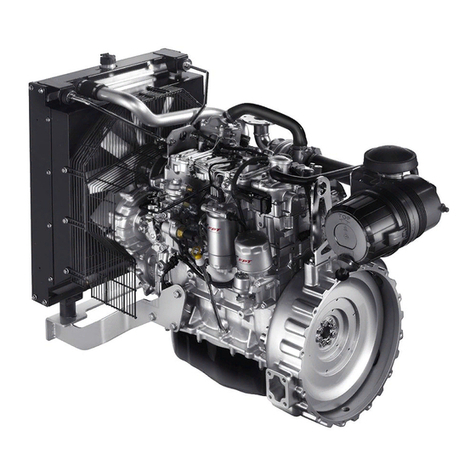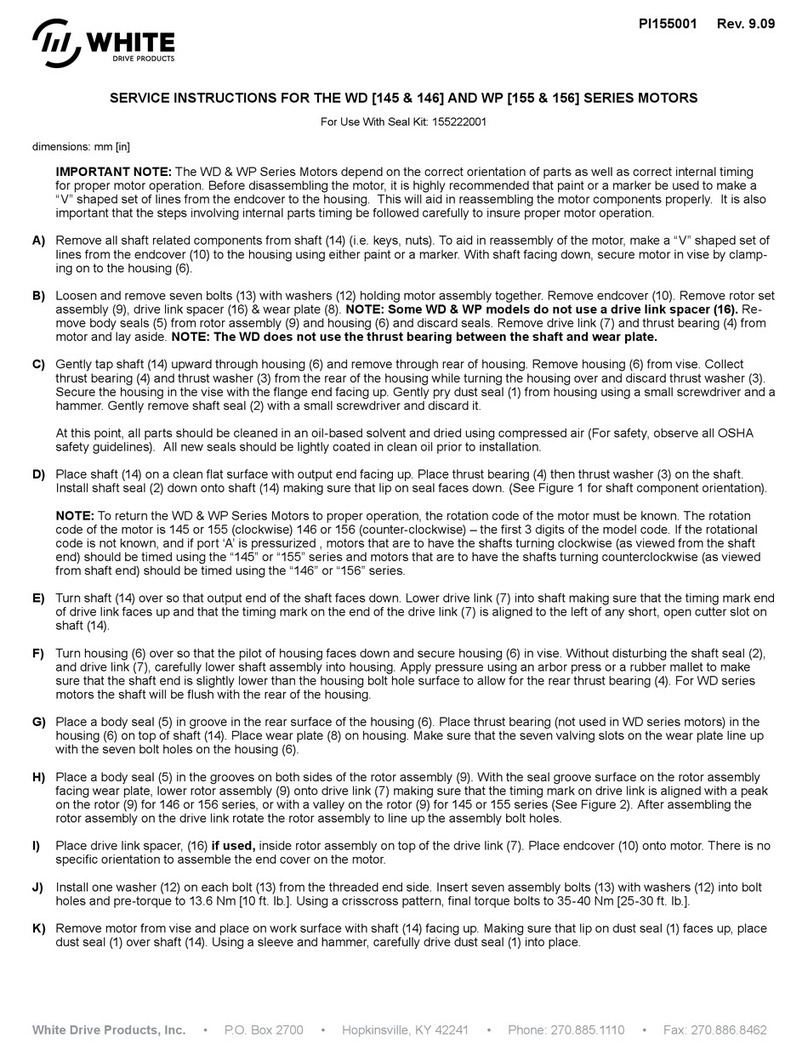
600928800000
Never touch, or allow any object to come
into contact with, the rotating propeller
and do not crouch over the engine when
it is running.
Adjust the throttle linkage so that the engine stops
when the throttle stick and trim lever on the
transmitter are fully retarded. Alternatively, the
engine may be stopped by cutting off the fuel supply.
Never try to stop the engine physically.
Take care that loose clothing (ties, shirt sleeves,
scarves, etc.)do not come into contact with the
propeller. Do not carry loose objects (such as
pencils, screwdrivers, etc.) in a shirt pocket from
where they could fall through the propeller arc.
Do not start your engine in an area containing loose
gravel or sand. The propeller may throw such
material in your face and eyes and cause injury.
For their safety, keep all onlookers (especially small
children) well back (at least 20 feet or 6 meters) when
preparing your model for flight. If you have to carry the
model to the take-off point with the engine running, be
especially cautious. Keep the propeller pointed away
from you and walk well clear of spectators.
Warning! Immediately after a glowplug-ignition
engine has been run and is still warm, conditions
sometimes exist whereby it is just possible for the
engine to abruptly restart if the propeller is casually
flipped over compression WITHOUT the glowplug
battery being reconnected. Remember this if you
wish to avoid the risk of a painfully rapped knuckle!
Always check the tightness of the propeller nut and
retighten it, if necessary, before restarting the engine.
Also, check the tightness of all the screws and nuts
before restarting the engine.
If you install a spinner, make sure that it is a precision
made product and that the slots for the propeller blades
do not cut into the blade roots and weaken them.
Preferably, use an electric starter. The wearing of
safety glasses is also strongly recommended.
Discard any propeller which has become split, cracked,
nicked or otherwise rendered unsafe. Never attempt to
repair such a propeller: destroy it.
Do not modify a propeller in any way, unless you are highly
experienced in tuning propellers for specialized competition
work such as pylon-racing.
Take care that the glow plug clip or battery leads do
not come into contact with the propeller. Also check
the linkage to the throttle arm. A disconnected linkage
could also foul the propeller.
After starting the engine, carry out any needle-valve
readjustments from a safe position behind the
rotating propeller. Stop the engine before attempting
to make other adjustments to the carburetor.
This engine was designed for model aircraft. Do not
attempt to use it for any other purpose.
Mount the engine in your model securely, following
the manufacturers' recommendations, using appropri-
ate screws and locknuts.
Be sure to use the silencer (muffler) supplied with the
engine. Frequent exposure to an open exhaust may
eventually impair your hearing. Such noise is also
likely to cause annoyance to others over a wide area.
Install a top-quality propeller of the diameter and pitch
specified for the engine and aircraft. Locate the
propeller on the shaft so that the curved face of the
blades faces forward-i.e. in the direction of flight. Firmly
tighten the propeller nut, using the correct size wrench.
If you remove the glowplug from the engine and
check its condition by connecting the battery leads to
it, do not hold the plug with bare fingers.Use an
appropriate tool or a folded piece of cloth.
NOTES
Model engine fuel is poisonous. Do not
allow it to come into contact with the eyes
ormouth.Alwaysstoreitinaclearlymarked
container and out of the reach of children.
Model engine fuel is also highly flammable.
Keep it away from open flame, excessive
heat, sources of sparks, or anything else
which might ignite it. Do not smoke or allow
anyone else to smoke, near to it.
Model engines generate considerable
heat. Do not touch any part of your
engine until it has cooled. Contact with
the muffler (silencer), cylinder head or
exhaust header pipe, in particular, may
result in a serious burn.
A weakened or loose propeller may disintegrate or
be thrown off and, since propeller tip speeds with
powerful engines may exceed 600 feet(180 metres)
per second, it will be understood that such a
failure could result in serious injury, (see 'NOTES'
section relating to propeller safety).
Never operate your engine in an enclosed space.
Model engines, like automobile engines, exhaust
deadly carbon-monoxide. Run your engine only in
an open area.
It is of vital importance, before attempting to operate your
engine, to read the general 'SAFETY INSTRUCTIONS
AND WARNINGS' in the following section and to strictly
adhere to the advice contained therein.
Also, please study the entire contents of this
instruction manual, so as to familiarize yourself with
the controls and other features of the engine.
SAFETY INSTRUCTIONS AND WARNINGS ABOUT YOUR O.S. ENGINE
The advice which follows is grouped under two
headings according to the degree of damage or
danger which might arise through misuse or neglect.
WARNINGS
NOTES
These cover events which might involve serious
(in extreme circumstances, even fatal) injury.
These cover the many other possibilities, generally less
obvious sources of danger, but which, under certain
circumstances, may also cause damage or injury.
WARNINGS
Remember that your engine is not a " toy ", but a
highly efficient internal-combustion machine whose
power is capable of harming you, or others, if it is
misused. As owner, you, alone, are responsible for
the safe operation of your engine, so act with
discretion and care at all times. If at some future
date, your O.S. engine is acquired by another
person, we would respectfully request that these
instructions are also passed on to its new owner.
Cylinder head
Venturi
Silicone Tube
Crankshaft
Propeller nut
Propeller washer
Drive Hub
Crankcase
Needle valve
Cover Plate
Fuel outlet
Fuel inlet
Glowplug
BASIC ENGINE PARTS
INSTALLATION
It is suggested to use as heavy and rigid as possible
engine mounting for highest performance and safe
running. Install the engine on a plastic mount using at
least 3mm steel screws, such as Allen type, with
locknuts, for bolting the engine to the bearers.
Use 3mm or larger steel screws, preferably Allen type
hexagon socket head cap screws, with washers and
locknuts, for bolting the engine to the bearers.
O.S. Radial Motor Mount
For 15LA-S / Code No.71909310
For 25LA-S / Code No.71908100
ABOUT THE ENGINE
NEEDLE-VALVE EXTENSION
INSTALLATION OF SILENCER
Secure the silencer to the engine by means of two
retaining screws supplied after the engine is securely
mounted to a test bench or a model.
The angled exhaust of the silencer can be rotated to
any desired position in the following manner:
Loosen the locknut and assembly screw.
Set the exhaust outlet at the required position by rotating
the rear part of the silencer.
Re-tighten the assembly screw, followed by the locknut.
1)
2)
3)
Make sure that the propeller is well balanced. An
unbalanced propeller and/or spinner can cause serious
vibration which may weaken parts of the airframe or
affect the safety of the radio-controlled system.
Warning:
Fuel Tank
A fuel tank of approximately 40cc capacity for 15LA-S
and 60cc capacity for 25LA-S is suggested.
BEFORE STARTING
Propellers
Glowplug battery
Fuel
Needle Valve Extension Cable Set (Code No.
72200080) is available from O.S. as an optional part.
It is recommended to seal the fitting faces of
engine exhaust and silencer with silicone sealant.
8x4
9x5
15LA-S
25LA-S
8x4-6
9x6, 10x5
Suggested propeller sizes are given in the table. As the
ideal propeller diameter, pitch and blade area vary
according to the size, weight and type of model, final
propeller selection can be made after practical experiment.
Aerobatic & Sport
Running-in
Make sure that these mounting beams are accurately
aligned and firmly integrated with the airframe,
reinforcing the adjacent structure to absorb vibration.
The "LA-S Series" engines are designed for control line
models. They have broad power characteristics which
are suitable for both trainer models and stunt models.
Aseparate needle-valve is mounted at the rear, where
manual adjustment is safely away from the rotating propeller.
Connect the short length of fuel tubing supplied
securely between the fuel outlet and the fuel inlet. In the
event of the tube becoming damaged, it should be
replaced with a suitable length of best quality 5mm
ODX2mm ID silicone tubing. Use similar material to
connect the fuel inlet nipple to the fuel tank.
Length
15LA-S
25LA-S
51-52mm
55-56mm
The 15LA-S and 25LA-S should be operated on a methanol
based fuel containing not less than 18% (volumetric) castor
oil, or a top quality synthetic lubricant (or a mixture of both),
plus a small percentage (5-10%) of nitromethane for
improved flexibility and power. Some commercial fuels
also contain coloring additives as an aid to fuel level
visibility. In some cases, these additives have indicated
slightly negative effects on the performance. We would
suggest that you use such fuels only if you are satisfied
that they do not adversely affect running qualities when
compared with familiar standard fuels. When changing
to a fuel brand or formula that is different from the one
to which you are accustomed, it is a wise precaution to
temporarily revert to in-flight running-in procedures,
until you are sure that the engine is running entirely
satisfactorily.
The power source for heating the glowplug
may be either a large heavy-duty 1.5volt
dry cell.
1.5 volt heavy-duty
dry battery
MAX-15LA-S / MAX-25LA-S




